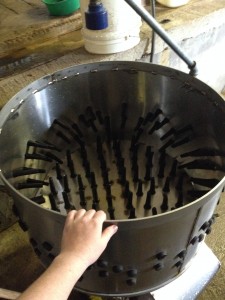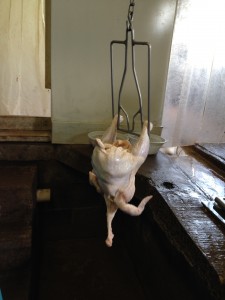As my summer went on, I transitioned from working primarily with the animals themselves to primarily selling their products at the markets. One task that remained constant, however, was the butchery. In order to sell fresh chickens every week, we need to kill every week. And so every Tuesday I pulled on my grimiest pair of jeans and headed out to catch some chickens.

Chickens not quite fat enough for slaughter
The QRS chickens are white Cornish cross breed, and usually are slaughtered at about six weeks of age. The goal is to have them dress at four pounds, so the exact number of chickens caught and processed every week depended on how effective the chickens were that week at eating and putting on weight. Usually, though, it was about 200 birds. Rick and Linda prefer the white chickens to the red chickens for meat production because the muscle doesn’t bruise as easily. They also regularly do custom butchering, either for people with home flocks that can’t bring themselves to butcher their own chickens, or for large orders from restaurants. Butchering 200 birds with only 4 people in a very small room is an all-day affair that ends with us exhausted and with questionable substances staining our clothing and crusted on our skin. And it all starts with catching. I’d never caught a chicken before coming to Quails-R-Us, unless you count picking up a friendly backyard chicken every now and then. To save my dignity and the time it would have taken me to chase chickens around trying to pick them up, someone somewhere invented a handy chicken hook that you can use to trip a chicken from the back and swiftly turn it upside down, which should, theoretically, calm it. I say theoretically because I had a lot of chickens that really didn’t like being held upside down in my fist and flapped furiously when they should have been still and stoic.

The plucker
The chickens are placed in plastic crates and wheeled over to the kill pit, which is the modified milking parlor from when the farm was a dairy. QRS uses the typical setup that I’ve used before when I’ve processed chickens: kill cones, a scalder, a plucking machine. Four or five birds are processed at a time, and cycled through the machines. Some weeks we also butcher quail and guineafowl for meat, which involve similar processes with some important differences. For instance, quail feathers require a different sized plucker than the larger birds, and it’s easier usually to just pluck them by hand. Quail feathers are also prone to melting beneath the skin if they stay in the scalder too long. The bald, warm, dead birds are taken from the plucker and put on a stainless steel table to be gutted. QRS cuts the head, neck, and feet off, saving the latter two for sale. Gutting a chicken may seem simple but it takes a significant amount of force to pull all the entrails out at once without shredding the lungs or tearing the heart from the liver. I very quickly learned it was more efficient for me to be on salvage duty: taking the entrails and separating the wastes from the marketable organs: the heart, liver, and gizzard. I observed a lot of variability in the deposits of internal fat, cut my hands on the very sharp bones of quail, popped way too many gallbladders [releasing a dark green fluid which stains the meat] and learned a lot of recipes for these unconventional ingredients. Chicken liver was actually the product we ran out of most often at the markets – demand far outstripped our supply, and chicken liver is hard to find in your neighborhood grocery.

About to break down a chicken by knife
Dressed birds were put on ice for several hours to chill, giving the workers a chance to clean up from the killing and break for lunch. Slaughter and gutting usually took about six hours. From mid-afternoon to early evening we packaged the chickens. Most are sold whole, with giblets – the neck, heart, liver, and gizzard – included. We also sold bags of individual pieces, like wings or thighs, bags of organs, feet, and necks, and a variety bag of pieces that was basically a whole chicken cut up already. Cutting was done with an industrial meatpacking saw I chose to stay far away from. I did get a chance to break down a chicken with a knife that was very informative for how the muscles are structured around the bones. The products are dried off, trimmed if needed, bagged, weighed, labelled with the date and weight, bagged again, and sealed, then placed in the walk-in cooler for sale that week. Anything not sold in that week – a very rare occurrence – is frozen for sale in future weeks. Record keeping during the rush of packaging is a must, to keep track of inventory for the week.
Chicken processing is a tedious and messy business but with good conversation flowing, waterproof boots, and a sturdy apron, it’s manageable. Helping put so many chickens on the table for our customers to enjoy definitely made me appreciate the effort that goes into my own food. I look forward to the next time I get to help process, and the next time I get to eat fresh chicken for dinner after a long day of work.
